Top Remote Team Collaboration Tools for Seamless Productivity
Explore the best remote team collaboration tools to boost your team’s efficiency. Find features, pricing, and use cases curated for success.
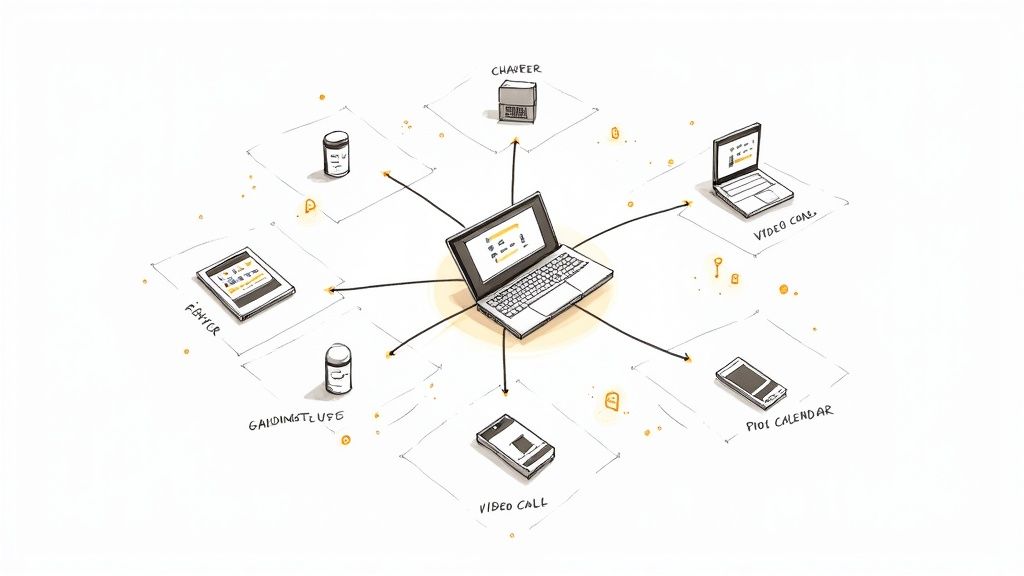
In a distributed workforce, selecting the right remote team collaboration tools is not just a matter of preference—it's a critical infrastructure decision that directly impacts velocity, code quality, and operational efficiency. Moving beyond generic feature lists, this guide provides a technical and actionable analysis of the top platforms designed for modern engineering and DevOps teams. We'll dissect each tool's core architecture, integration capabilities via APIs and webhooks, and specific use cases, from managing complex CI/CD pipelines to fostering asynchronous knowledge sharing.
This deep dive is structured to help startup founders, CTOs, and engineering leaders make informed decisions. We focus on practical implementation considerations, such as configuring integrations, setting up automated workflows, and managing permissions at scale. For a broader perspective on the evolving landscape of remote collaboration, you can explore other comprehensive guides like the 12 Best Remote Work Collaboration Tools for 2025 for additional insights.
You'll learn how to evaluate these platforms based on your team’s specific technical stack, workflow maturity, and security requirements. Our analysis, complete with screenshots and direct links, will help you implement a solution that scales with your ambitions and empowers your engineers to build, ship, and innovate faster, regardless of location.
1. OpsMoon
OpsMoon provides a unique, service-based approach to remote technical collaboration. Instead of offering a SaaS tool, it delivers pre-vetted, elite DevOps engineering teams as a managed service. This is particularly effective for organizations needing to implement complex infrastructure projects—like a Kubernetes migration or establishing a robust CI/CD pipeline with Terraform—without the long lead times of direct hiring. The platform's value proposition is its ability to deploy a cohesive, high-functioning remote team that integrates directly into your existing toolchain and workflows.
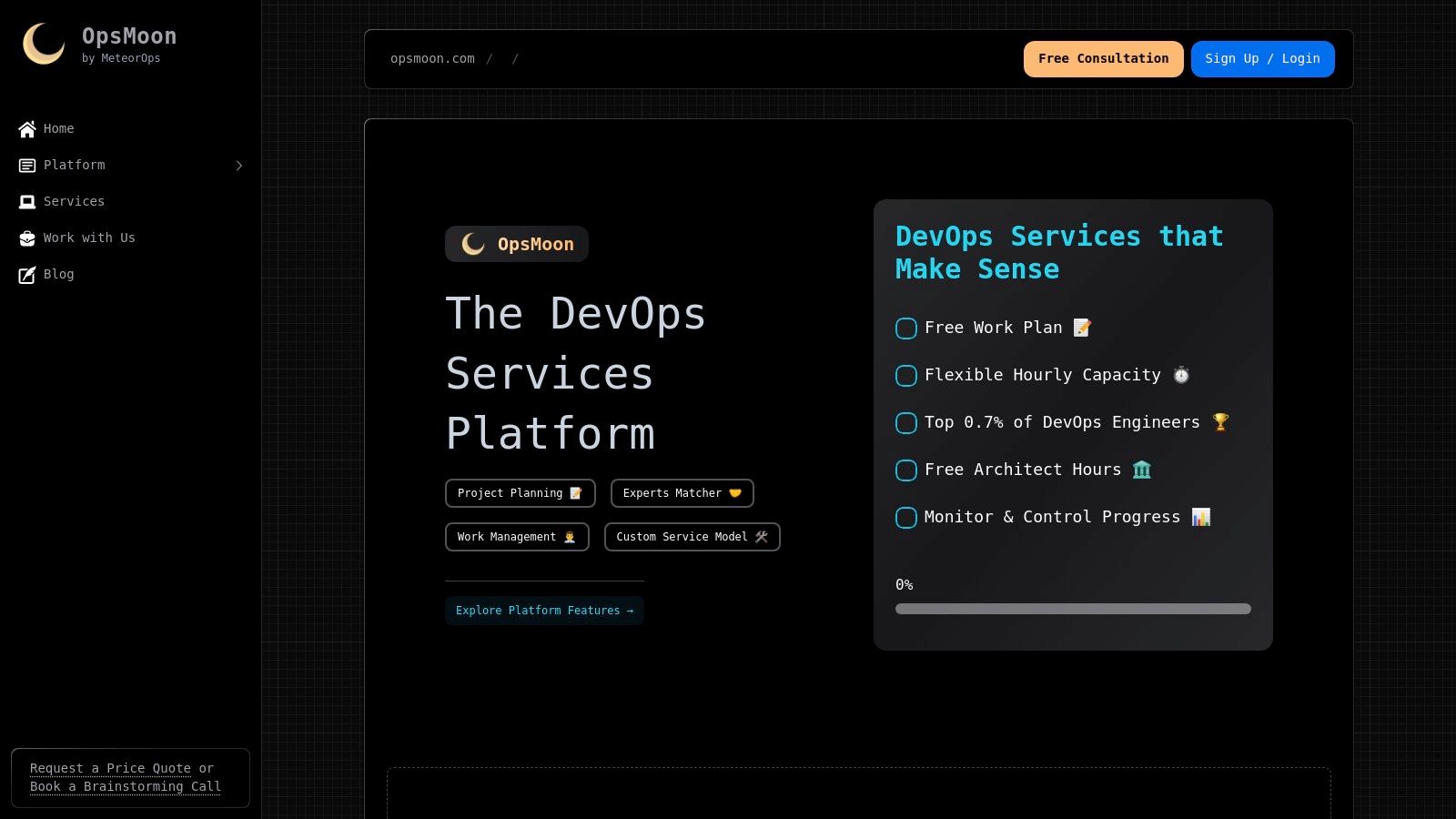
The collaboration protocol begins with a technical deep-dive and work planning session, where your existing architecture (e.g., cloud provider, container orchestration, IaC tools) is analyzed to create a detailed project roadmap with clear deliverables and SLOs. OpsMoon’s proprietary Experts Matcher algorithm then assembles a team with certified expertise in your specific stack. This technical alignment is paramount for remote work, ensuring the team can immediately contribute to your codebase and infrastructure without a steep learning curve.
Strategic Advantages and Use Cases
OpsMoon is engineered for scenarios where deep, specialized technical execution is required, and off-the-shelf tools are insufficient.
- Best For: Companies needing to execute specific, high-stakes DevOps projects, such as building out observability stacks with Prometheus and Grafana, automating cloud infrastructure with Infrastructure as Code (IaC), or augmenting an existing team with specialized SRE skills.
- Key Feature: The inclusion of free architect hours provides senior-level technical oversight, ensuring that the remote team's tactical work aligns with broader architectural goals and security best practices. This is crucial for maintaining architectural integrity during rapid development.
- Practical Tip: To maximize the value of the initial planning session, prepare a repository with your current Terraform or CloudFormation scripts, CI/CD pipeline configurations (e.g.,
.gitlab-ci.ymlor Jenkinsfile), and any existing architectural diagrams. This enables a more precise and actionable roadmap.
OpsMoon’s operational model is designed for technical integration, offering engagement flexibility from advisory roles to full project ownership. This makes it one of the most effective remote team collaboration tools when the "tool" needed is actually a highly specialized, remote-native engineering unit. You can explore a curated list of DevOps instruments and how they integrate into a cohesive strategy by checking out the expert-recommended toolsets on Opsmoon.com.
Pros & Cons
| Pros | Cons |
|---|---|
| Elite Talent Access: Connects you with the top 0.7% of vetted global DevOps engineers via its Experts Matcher technology. | Opaque Pricing: Cost information is not public; a customized quote is required. |
| Strategic Onboarding: A free, comprehensive work planning session ensures strategic alignment and a clear project roadmap. | Remote-Only Model: May not be suitable for organizations that require an on-site presence. |
| Flexible Engagement: Offers models from consulting and hourly capacity to full project delivery, with free architect hours included. | |
| High Transparency: Provides real-time progress tracking and a focus on continuous improvement cycles for project control. |
Website: https://opsmoon.com
2. Microsoft Teams (Microsoft 365 + Teams Essentials)
For engineering teams operating within the Azure and Microsoft 365 ecosystem, Teams offers a tightly integrated collaboration hub. Its core technical advantage is its native integration with Azure DevOps and GitHub Enterprise. Development teams can create channels that receive real-time notifications from ADO pipelines for build successes or failures, pull request updates, and work item assignments. This transforms the chat interface into a functional command center, reducing the need to switch contexts between communication and development tools.
Architecturally, Teams leverages SharePoint for file storage and Exchange for calendaring, ensuring robust, enterprise-grade data management and security policies. The ability to embed Power BI dashboards or SharePoint lists as tabs within a channel allows for the creation of project-specific cockpits that display key metrics and data without leaving the application. For organizations prioritizing security, Microsoft's compliance and data governance features, inherited from the broader M365 suite, are a significant differentiator.
Key Considerations
- Best Use Case: Development teams standardized on Azure DevOps for CI/CD and work item tracking, and organizations that require stringent, centralized security and compliance controls.
- Pros: Vendor consolidation and simplified billing within the Microsoft ecosystem; powerful, native integrations with Azure services; robust security features including eDiscovery and data loss prevention (DLP).
- Cons: The most powerful integrations require a full Microsoft 365 E3/E5 subscription. The user interface can feel less streamlined than competitors like Slack, especially for non-technical users.
Website: https://www.microsoft.com/en-us/microsoft-teams/essentials/
3. Slack (by Salesforce)
Slack is a developer-centric communication platform that excels at integrating a heterogeneous toolchain into a unified, actionable stream of events. Its power lies in a vast ecosystem of applications and a robust API that allows for the creation of custom workflows and "slash" commands. Technical teams can configure integrations to pipe alerts from monitoring systems like Datadog or Prometheus, receive deployment notifications from Jenkins or CircleCI, and manage Jira tickets directly from a chat channel.
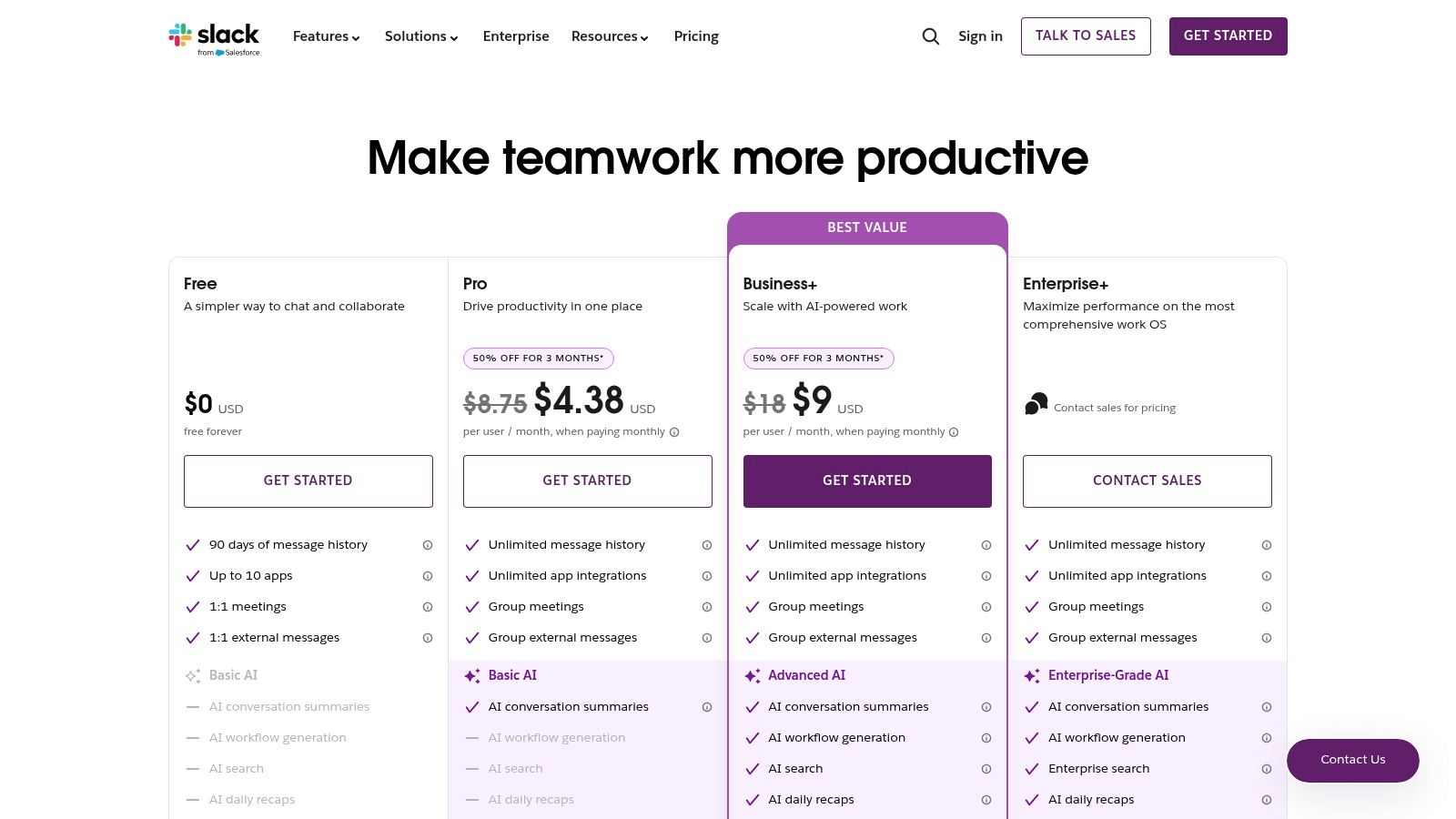
The platform’s "Workflow Builder" provides a no-code interface for automating routine processes, such as creating a standardized incident response channel when a PagerDuty alert is triggered. For more complex automation, Slack's APIs enable developers to build custom bots and applications that can interact with internal services. Slack Connect extends this collaborative fabric to external partners, providing a secure, shared workspace that is more efficient and auditable than email.
Key Considerations
- Best Use Case: Agile engineering teams with a diverse, best-of-breed toolchain who need a central hub for notifications, automation, and real-time incident response.
- Pros: Unmatched app ecosystem and powerful APIs for custom integrations; intuitive UX for chat and asynchronous communication; Slack Connect enables secure external collaboration.
- Cons: Message history is severely limited on the free plan, hindering its use as a long-term knowledge base. Per-user costs on paid plans can become significant for large teams.
Website: https://slack.com/pricing
4. Zoom Workplace (Meetings, Team Chat, Whiteboard, Phone add-ons)
While known for its best-in-class video conferencing, Zoom Workplace has evolved to become a more integrated collaboration platform. Its primary technical advantage is the seamless transition between asynchronous and synchronous communication modes. A discussion in a Team Chat channel can be escalated to a high-fidelity video call with a single click, preserving the chat history and context. This is highly effective for remote pair programming or urgent troubleshooting sessions where text-based communication is insufficient.
For remote engineering teams, the platform's reliability and low-latency video are critical for daily stand-ups, sprint planning, and retrospectives. The integrated Whiteboard feature is useful for system design sessions and architectural diagramming. While its app ecosystem is not as extensive as Slack's, it offers key integrations with project management tools like Asana and Jira. The AI Companion feature, which can summarize meetings and generate action items, provides a tangible productivity boost by reducing manual documentation overhead.
Key Considerations
- Best Use Case: Teams that prioritize high-quality video for daily synchronous collaboration and want to consolidate their communication tools under a single, familiar vendor.
- Pros: Industry-leading video quality and reliability; Team Chat is included with paid meeting licenses, offering immediate value; simple, intuitive user experience minimizes training requirements.
- Cons: The integration marketplace is less mature than competitors. Advanced features, particularly for telephony and large-scale webinars, are expensive add-ons.
Website: https://www.zoom.com/en/products/team-chat/
5. Google Workspace (Gmail, Drive, Meet, Chat)
Google Workspace is a fully cloud-native suite designed for real-time, browser-based collaboration. Its key technical strength is the deep, seamless integration between its component services. For example, users can collaborate on a Google Doc directly within a Chat space, initiate a Meet call from a calendar invite, and leverage powerful search capabilities across Gmail and Drive. This frictionless experience minimizes context switching and eliminates version control issues associated with desktop applications.
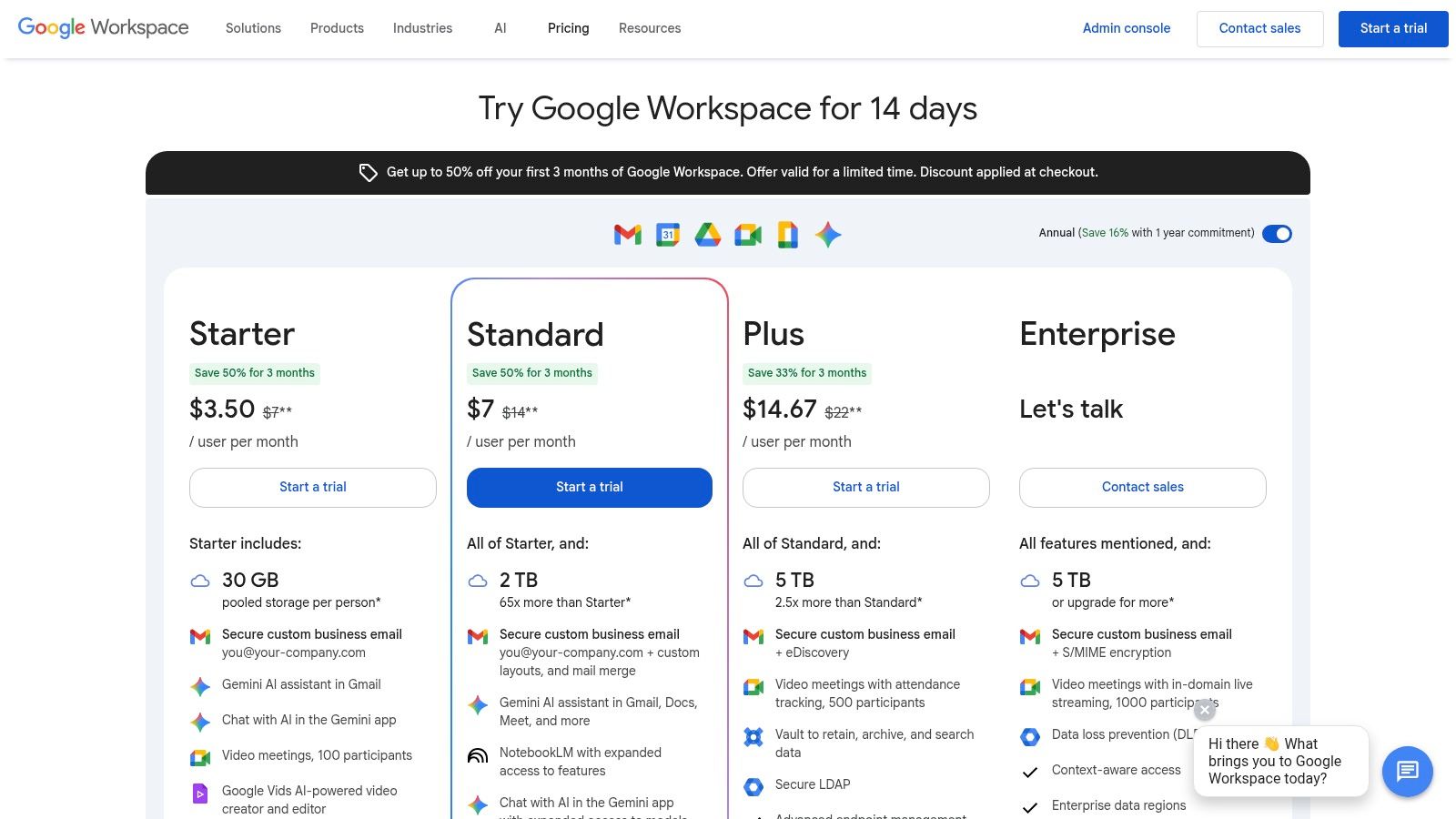
For technical teams, Google Colab and the ability to use Google Apps Script provide powerful ways to extend the platform's functionality. Apps Script, a JavaScript-based platform, allows for the creation of custom add-ons and automation workflows across the entire suite. The platform's security model is robust, with granular sharing controls in Drive, data loss prevention (DLP) policies, and security analytics available in higher-tier plans. For teams evaluating total cost, a breakdown of Google Workspace pricing shows its competitive positioning.
Key Considerations
- Best Use Case: Fast-moving teams that depend on real-time document co-authoring and prefer a unified, browser-first environment for all productivity and communication needs.
- Pros: Unparalleled real-time collaboration in Docs, Sheets, and Slides; simplified, transparent per-user pricing; robust cloud-native security and admin controls.
- Cons: Less suitable for organizations with heavy dependencies on Microsoft Office desktop features or complex macros. The third-party app marketplace is not as extensive as those of Microsoft or Slack.
Website: https://workspace.google.com/pricing?hl=us
6. Atlassian Cloud (Jira Software + Confluence)
The Atlassian suite, centered around Jira and Confluence, is the de facto standard for structured agile software development at scale. Jira's power lies in its highly customizable workflows, which can be tailored to model any development process from simple Kanban to complex, multi-stage release cycles. Its use of Jira Query Language (JQL) allows for the creation of sophisticated filters and dashboards to track metrics like cycle time, lead time, and bug velocity.
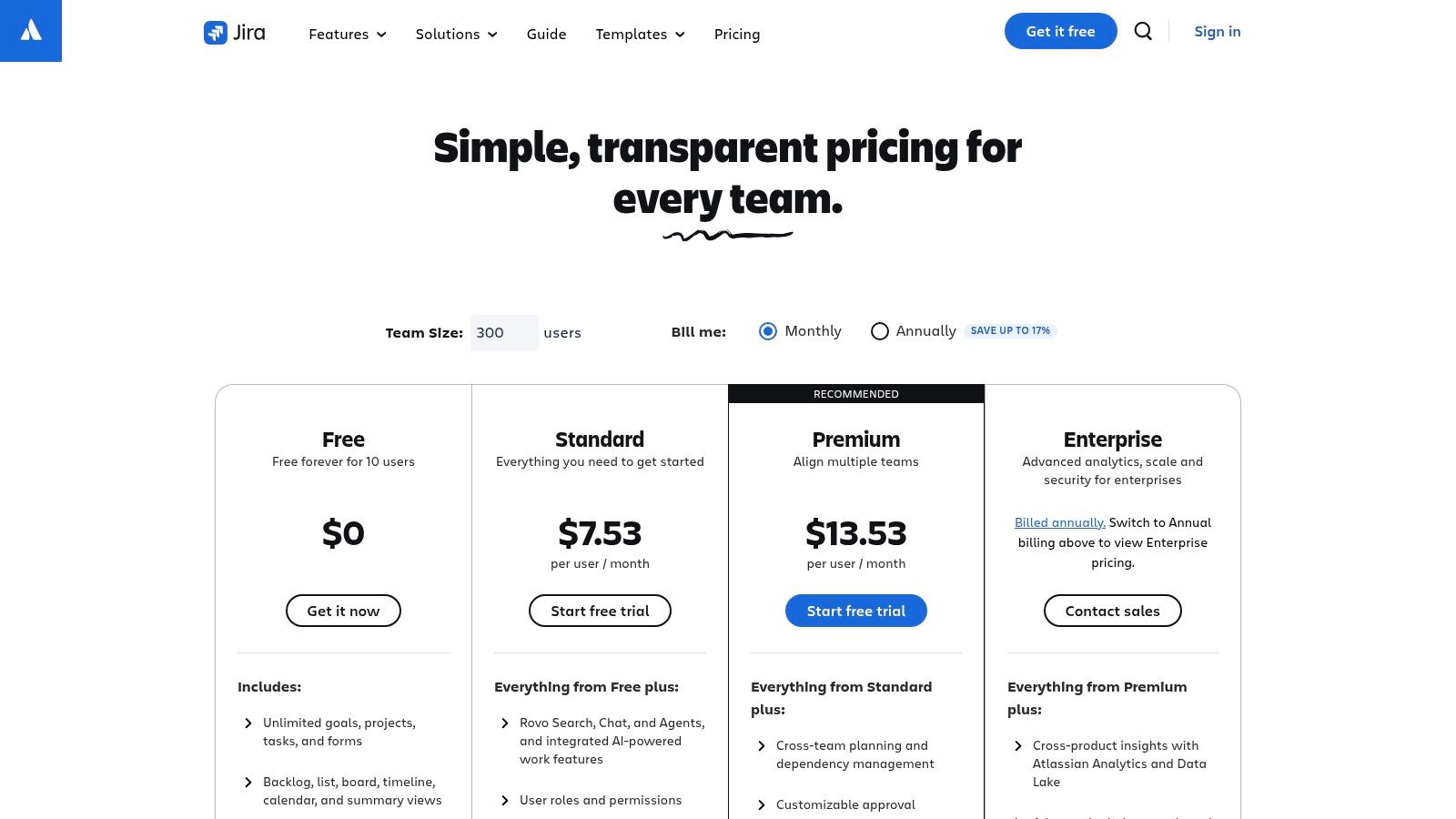
Confluence serves as the integrated knowledge base, providing a single source of truth for technical specifications, architectural decision records (ADRs), and sprint retrospectives. The deep, two-way integration between the two is critical: Jira epics can be linked to Confluence requirements pages, and code commits in Bitbucket or GitHub can automatically update the status of Jira tickets. This creates a fully traceable and auditable record of work from ideation to deployment, which is essential for regulated industries and large engineering organizations.
Key Considerations
- Best Use Case: Software development teams that require a prescriptive, auditable system for managing the entire software development lifecycle (SDLC) in an agile framework.
- Pros: Best-in-class for structured issue and project tracking; powerful integration with CI/CD and Git hosting platforms; strong compliance and security features for enterprise use.
- Cons: Can be perceived as overly complex or rigid for smaller, faster-moving teams. The per-user pricing model can become expensive as teams scale and require marketplace add-ons.
Website: https://www.atlassian.com/software/jira/pricing
7. Asana (Work Management for teams)
Asana excels at translating high-level strategic objectives into actionable, trackable tasks for distributed teams. Its technical strength is its robust data model, which allows for the creation of dependencies between tasks across different projects. This is crucial for remote teams, providing clear visibility into how a delay in one area will impact timelines elsewhere. The "Portfolio" and "Goals" features allow engineering leaders to monitor the real-time status of multiple projects and initiatives against strategic business outcomes.
For development workflows, Asana's automation engine ("Rules") can be used to streamline processes, such as moving a task to a "QA" column when a corresponding pull request is merged in GitHub. Its API is well-documented, enabling custom integrations with internal systems. While not as developer-centric as Jira, Asana's user-friendly interface makes it an excellent choice for cross-functional teams where engineers, product managers, and marketers need to collaborate within a single system.
Key Considerations
- Best Use Case: Cross-functional teams that need to manage complex projects with interdependencies and require a clear line of sight from individual tasks to company-wide goals.
- Pros: Highly intuitive interface with multiple project views (list, board, timeline, calendar); powerful automation capabilities to reduce manual work; strong reporting and portfolio management features.
- Cons: Not specifically designed for agile software development methodologies like Scrum (e.g., lacks native story points). Advanced features like workflow branching are tied to expensive higher-tier plans.
Website: https://www.forbes.com/advisor/business/asana-pricing/
8. monday.com Work Management
monday.com is a highly customizable Work OS that allows teams to build their own applications and workflows using a visual, low-code interface. Its technical advantage is its extreme flexibility. Teams can create boards with custom column types (e.g., status, timeline, numbers, formulas) to precisely model their specific processes, whether for bug tracking, sprint planning, or marketing campaigns. The platform’s robust automation and integration recipes allow for deep connections with external tools.
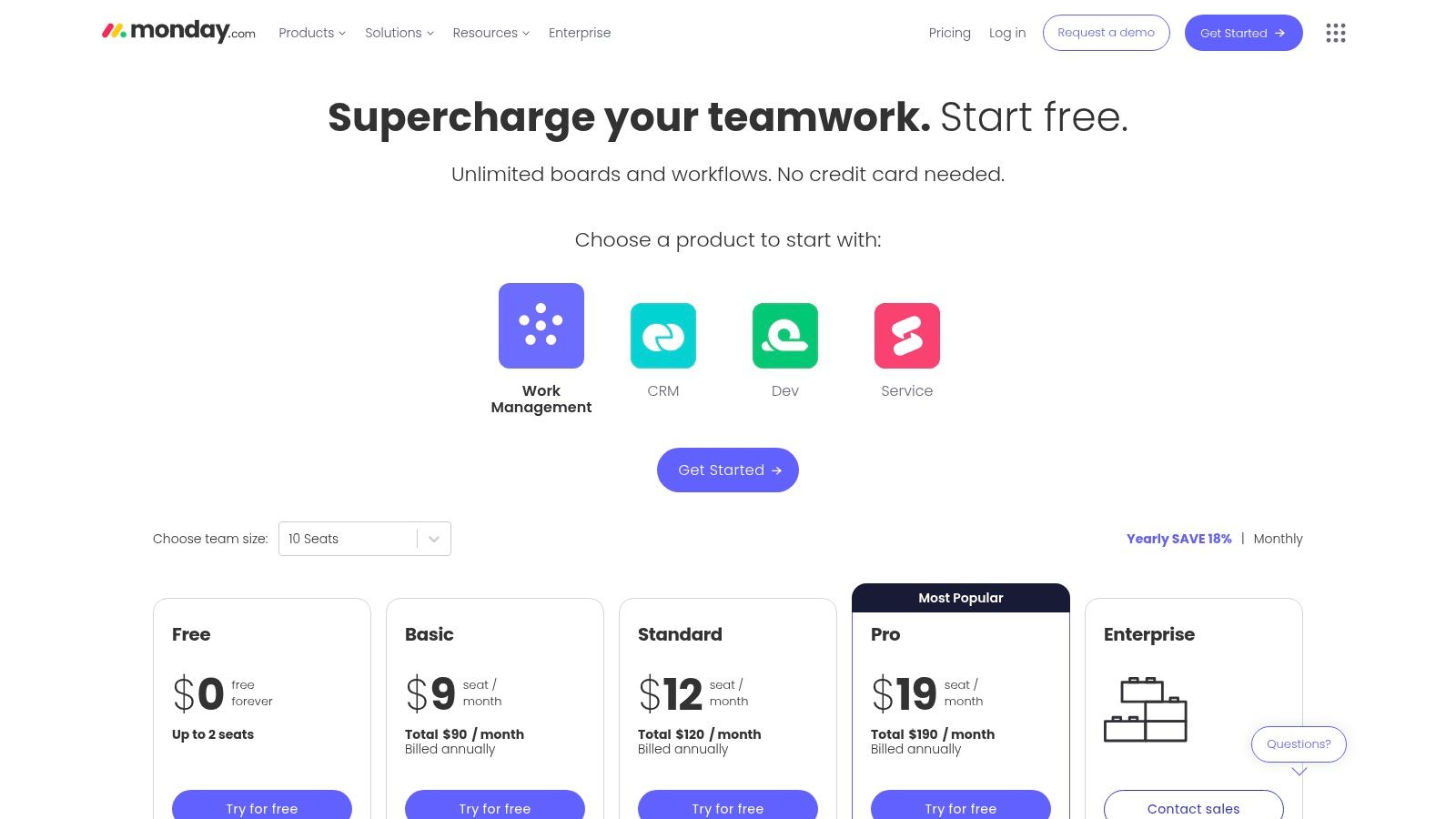
For development teams, the monday dev product offers specialized features like sprint management and roadmap planning, with native integrations for GitHub, GitLab, and Jira. This allows managers to visualize data from multiple sources on a single dashboard. A key technical feature is its GraphQL API, which provides more efficient and flexible data retrieval compared to traditional REST APIs, empowering developers to build sophisticated custom integrations and reporting tools.
Key Considerations
- Best Use Case: Teams that require a highly visual and customizable platform to manage a wide variety of workflows and consolidate data from multiple sources into centralized dashboards.
- Pros: Extremely flexible and visually intuitive interface; extensive library of automation and integration recipes; a powerful GraphQL API for custom development.
- Cons: The seat-bundle pricing model (minimum of 3 seats) can be cost-prohibitive for very small teams. The sheer number of customization options can be overwhelming without a clear implementation plan.
Website: https://www.monday.com/pricing
9. ClickUp
ClickUp's core technical proposition is consolidation. It aims to provide a single, unified platform with a feature set that spans project management, document collaboration, whiteboarding, and even internal chat. Its hierarchical structure (Spaces > Folders > Lists > Tasks) allows for a high degree of organizational granularity, making it suitable for mapping complex organizational structures and project portfolios. The ability to create custom fields and statuses at different levels of this hierarchy provides significant flexibility.
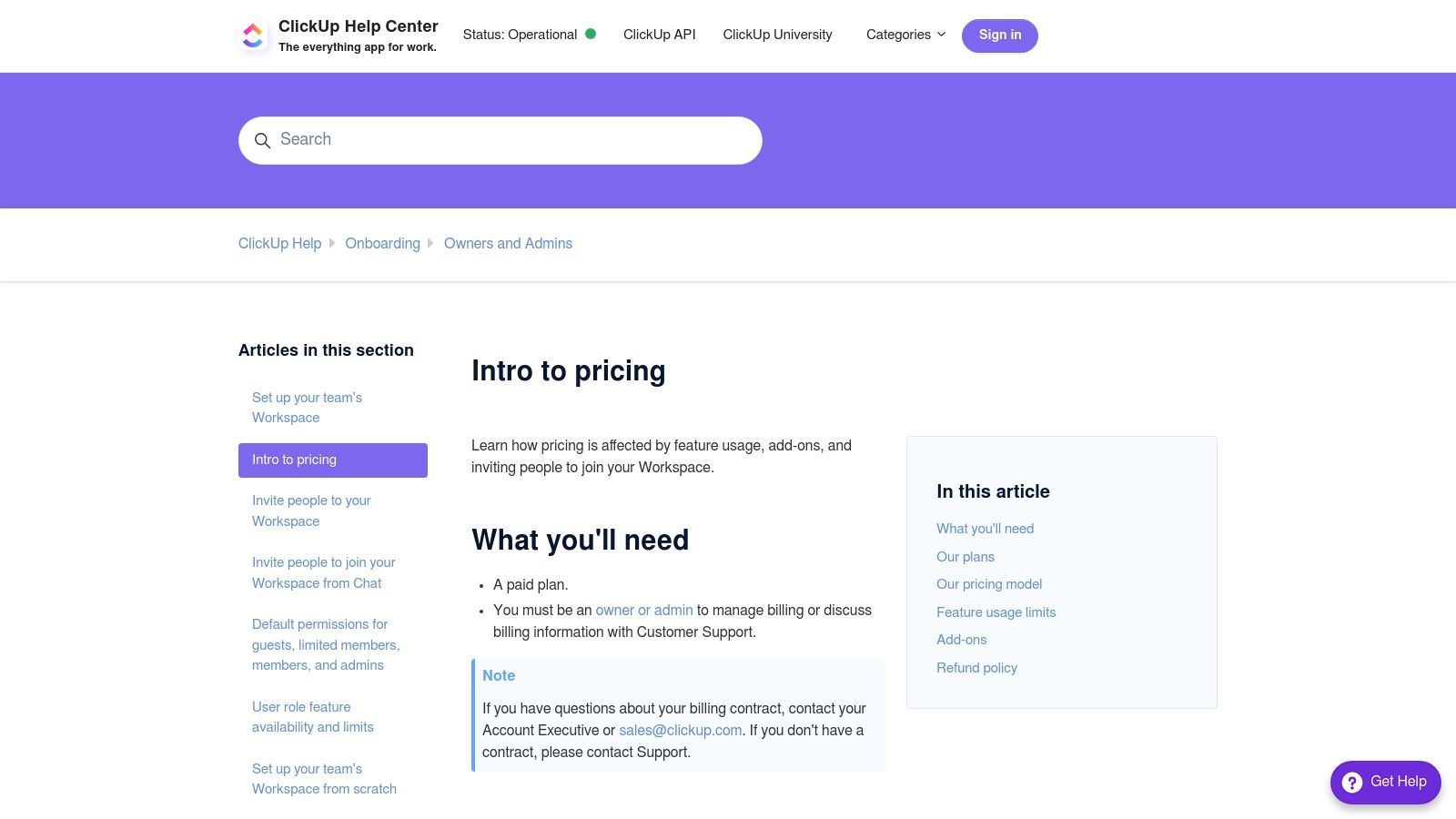
For technical teams, ClickUp offers multiple views, including Gantt, Kanban, and workload charts, to manage sprints and allocate resources. Its API is comprehensive, allowing for programmatic interaction with nearly every aspect of the platform. Features like "Goals" for tracking objectives and key results (OKRs) and integrated time tracking make it a powerful tool for managers needing to monitor team performance and project progress in one place.
Key Considerations
- Best Use Case: Cost-conscious teams looking for an all-in-one solution to reduce the number of subscribed SaaS tools and centralize all work management activities.
- Pros: An extensive, all-encompassing feature set at a competitive price point; highly customizable structure and views; a public API that enables deep integration.
- Cons: The breadth of features can lead to a steep learning curve and a cluttered user interface. Performance can sometimes be sluggish, particularly on large or complex boards.
Website: https://help.clickup.com/hc/en-us/articles/10129535087383-Intro-to-pricing
10. Notion
Notion's technical architecture is built around a flexible, database-driven structure where every piece of content is a "block." This allows for the creation of interconnected wikis, task lists, and project roadmaps that are far more dynamic than traditional documents. For engineering teams, this means you can create a project brief that directly links to a Kanban board of tasks, which in turn links to detailed technical specification pages. This relational database model is Notion’s core differentiator.
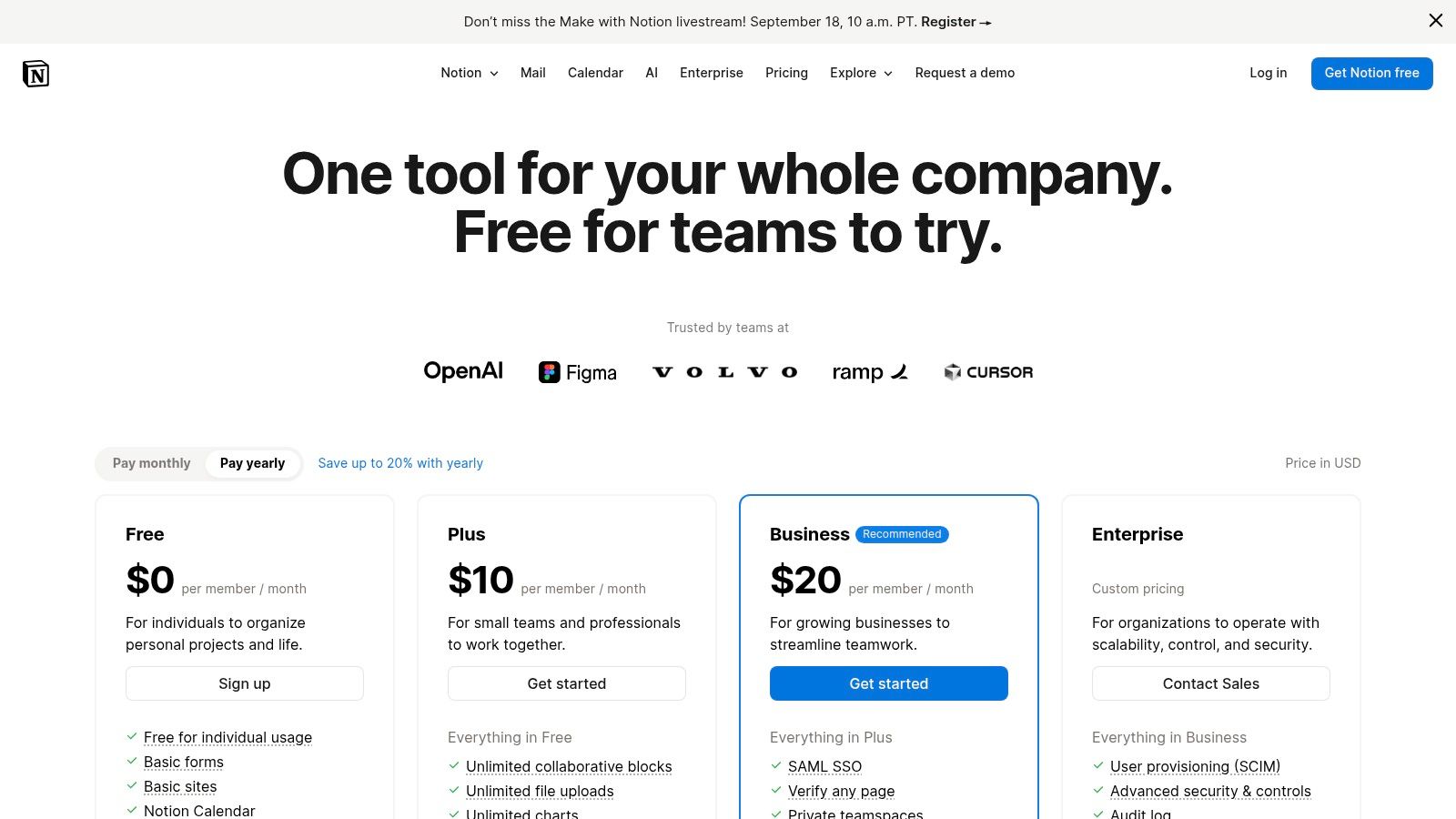
The platform has a public API, allowing for the automation of page and database entry creation, which is useful for integrating with other systems like GitHub or Jira. Notion AI can be used to summarize lengthy technical documents, generate boilerplate code, or draft meeting agendas, accelerating routine tasks. The ability to create team-specific templates ensures consistency in documentation, such as for architectural decision records (ADRs) or incident post-mortems.
Key Considerations
- Best Use Case: Teams that prioritize knowledge management and documentation and want a single, highly customizable tool to serve as their "team brain."
- Pros: Unmatched flexibility for creating custom workflows and documentation systems; a powerful relational data model for linking information; a clean, minimalist user interface.
- Cons: Lacks the robust, dedicated project management features of tools like Jira or Asana (e.g., advanced reporting, resource management). Can become disorganized without strong governance and standardized templates.
Website: https://www.notion.com/pricing
11. Miro (Visual Collaboration & Whiteboarding)
Miro provides a persistent, infinite digital canvas that is essential for remote technical collaboration, particularly during the ideation and design phases. It goes beyond basic whiteboarding by offering a rich set of tools and templates specifically for software development, such as user story mapping, dependency mapping, and system architecture diagramming using standard notations like C4 or UML. The ability for multiple users to collaborate in real-time on these complex diagrams is its core function.
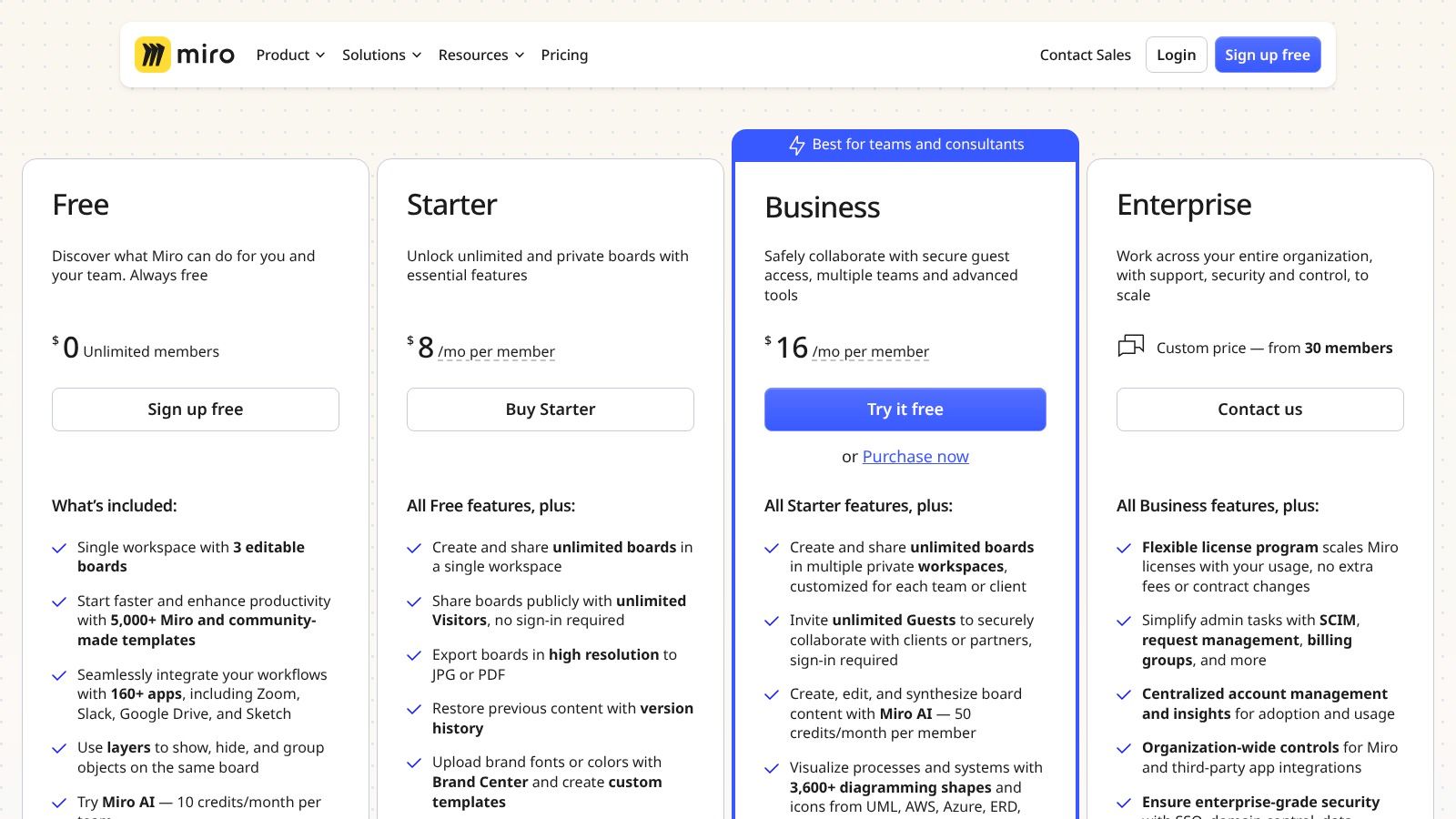
A key technical feature is its two-way synchronization with issue-tracking systems like Jira and Azure DevOps. This allows teams to convert digital sticky notes from a brainstorming session directly into actionable tickets in their backlog. The Miro Developer Platform enables the creation of custom applications and integrations, allowing teams to embed Miro boards into other applications or pull data from external services onto a board.
Key Considerations
- Best Use Case: Distributed engineering, product, and design teams that need a shared visual space for workshops, system architecture planning, and agile ceremonies like sprint retrospectives.
- Pros: Extensive template library for technical and agile workflows; powerful, real-time visual collaboration features; deep two-way integrations with key development tools.
- Cons: The free plan's limit of three editable boards is highly restrictive for active teams. Can become another "silo" of information if not tightly integrated with a system of record like Jira or Confluence.
Website: https://miro.com/pricing/
12. AWS Marketplace (Collaboration & Productivity category)
The AWS Marketplace is a procurement and deployment channel rather than a collaboration tool itself. Its technical value lies in streamlining the acquisition, billing, and governance of third-party SaaS tools for organizations heavily invested in the AWS cloud. By procuring software through the Marketplace, companies can consolidate their SaaS spending onto their AWS bill, simplifying budget management and potentially leveraging existing Enterprise Discount Programs (EDPs).
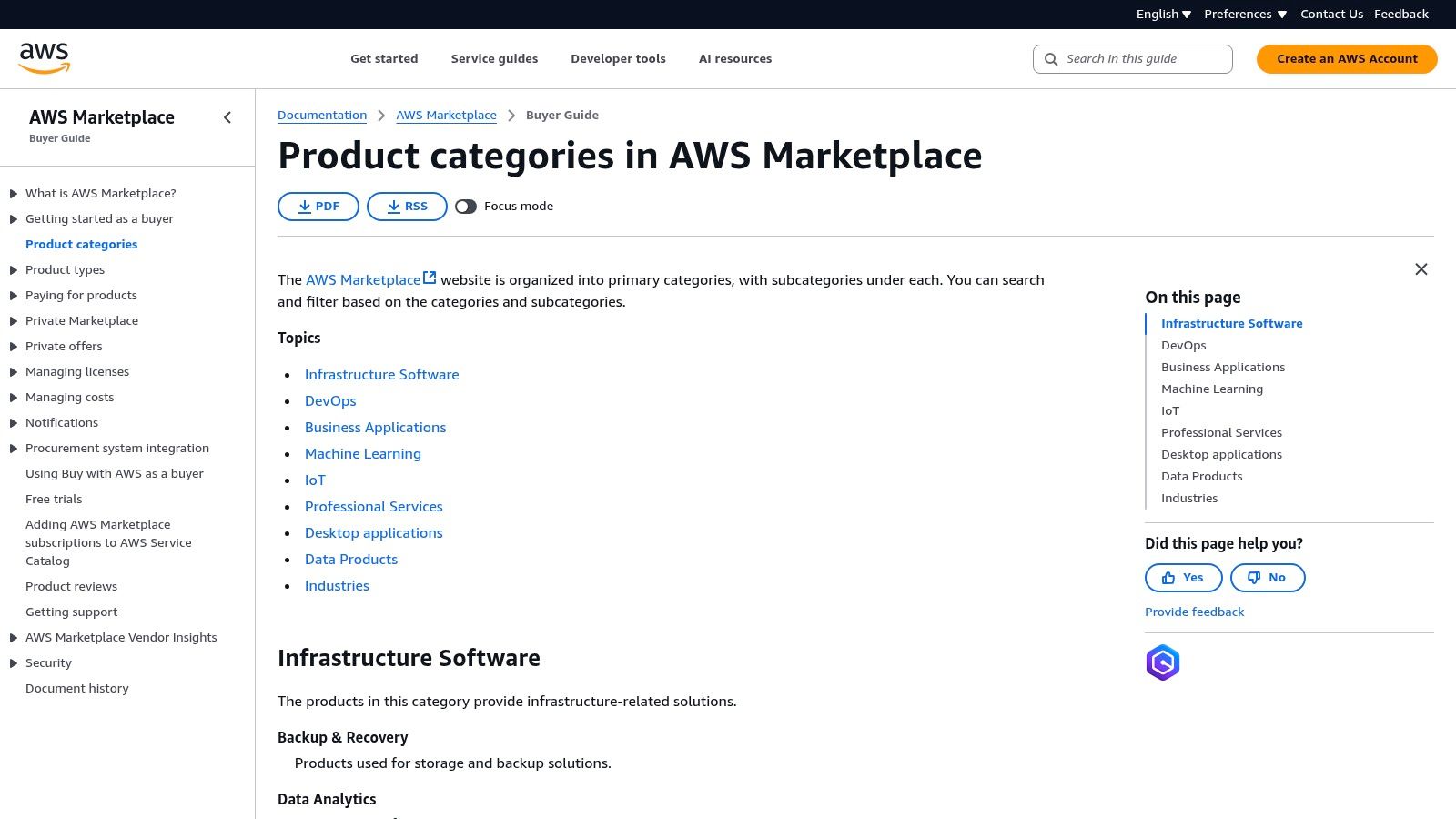
For a remote DevOps engineer, this model accelerates access to necessary tools by bypassing lengthy, traditional procurement cycles. The Marketplace also simplifies security and compliance, as many listed products have been vetted by AWS. Furthermore, private offers allow organizations to negotiate custom pricing and licensing terms directly with vendors, all managed within the AWS ecosystem. This operational efficiency allows engineering teams to focus on development rather than administrative overhead.
Key Considerations
- Best Use Case: Large organizations with significant AWS spend and established procurement processes looking to simplify vendor management and consolidate billing for their software stack.
- Pros: Centralized billing and procurement under the AWS umbrella; simplified security and compliance vetting; potential for cost savings through negotiated private offers and EDPs.
- Cons: Tool selection is limited to vendors who have chosen to list on the Marketplace. Pricing may not always be more competitive than purchasing directly from the vendor.
Website: https://docs.aws.amazon.com/marketplace/latest/buyerguide/buyer-product-categories.html
Top 12 Remote Collaboration Tools Feature Comparison
| Platform | Core Features | User Experience / Quality | Value Proposition | Target Audience | Price Points |
|---|---|---|---|---|---|
| OpsMoon | Top 0.7% remote DevOps talent, Experts Matcher, Kubernetes, Terraform, CI/CD, observability | Free planning session, real-time progress tracking, continuous improvement | Flexible models, free architect hours, tailored roadmap, remote-first | Startups, SMEs, enterprises needing DevOps expertise | Custom pricing, quote required |
| Microsoft Teams (Microsoft 365 + Teams Essentials) | Team chat, meetings (up to 300 users), Office integration, file collaboration | Familiar UI, integrated Office apps | All-in-one communication & productivity | Teams using Microsoft Office | Teams Essentials from $4/user/month+ |
| Slack (by Salesforce) | Channels, calls, 2600+ apps & integrations, Slack Connect | Best-in-class chat UX, rich integrations | Flexible pricing, external collaboration | Teams needing rich chat & integrations | Free tier, paid from $6.67/user/month |
| Zoom Workplace | Video meetings, team chat, whiteboarding, phone add-ons | Reliable video, chat included, AI companion | Extend Zoom meetings to full collaboration | Video meeting heavy teams | Pricing varies by plan and add-ons |
| Google Workspace | Gmail, Drive, Docs/Sheets, Meet, Chat | Seamless real-time collaboration | All-in-one cloud productivity suite | Cloud-centric teams | From $6/user/month |
| Atlassian Cloud (Jira + Confluence) | Issue tracking, agile boards, wikis, permissions, integrations | Structured work tracking, centralized docs | Agile management, knowledge base | Agile teams, dev & documentation users | Free tier, paid from $7.75/user/month |
| Asana | Tasks, boards, timelines, automation, reporting | Intuitive UI, templates, onboarding options | Project & task management with automation | Cross-functional teams | Free tier, paid from $10.99/user/month |
| monday.com Work Management | Visual boards, timelines, automations, CRM & dev modules | Visual, template-rich, AI features | Flexible modules for projects & CRM | Teams needing visual management | From $8/user/month (seat bundles) |
| ClickUp | Tasks, docs, whiteboards, goals, chat, dashboards | Broad features, aggressive roadmap | All-in-one collaboration platform | Teams replacing multiple tools | Free tier, paid from $5/user/month |
| Notion | Docs, wikis, databases, AI writing/search | Flexible building blocks, simple pricing | Unified knowledge & lightweight PM | Teams needing flexible docs | Free tier, paid from $8/user/month |
| Miro | Infinite canvas, templates, timers, voting, enterprise security | Strong facilitation tools, integrations | Visual collaboration & workshops | Remote/hybrid teams | Free tier, paid from $8/user/month |
| AWS Marketplace (Collab & Productivity) | Curated SaaS apps, consolidated billing, procurement | Centralized vendor management | Simplifies AWS-centric software procurement | Large orgs with AWS spend | Varies by vendor |
Making Your Final Decision: Integrating the Right Tools for Your DevOps Workflow
Choosing the right stack of remote team collaboration tools is a critical strategic decision that directly impacts your team's culture, efficiency, and technical output. The optimal solution is rarely a single platform but an integrated ecosystem where communication, project management, and knowledge sharing are connected via robust APIs and automated workflows. The objective is to architect a digital workspace that minimizes friction and provides a high-fidelity signal of project status and team health.
Synthesizing Your Tooling Strategy
For highly technical teams, particularly within a DevOps or SRE context, the selection criteria go far beyond simple chat or video conferencing features. The emphasis must be on platforms with robust APIs, deep integrations with your existing developer toolchain (like Git repositories, CI/CD pipelines, and observability platforms), and granular permission controls. When evaluating options like Atlassian's Jira and Confluence versus a more flexible platform like Notion or ClickUp, consider your team's existing software delivery lifecycle. A tool should not force a new, cumbersome process; it should augment and streamline the workflows you already have in place.
Key Factors for Technical Implementation
As you move from evaluation to implementation, consider these critical factors:
- Integration Debt: How much custom development or third-party middleware (like Zapier or Make) will be required to connect your chosen tools? A platform with native, deep integrations into your core stack (e.g., Slack's Git and Jenkins apps) will always be superior to one requiring brittle, custom-built connectors. Analyze the quality of the API documentation and the availability of webhooks for event-driven automation.
- Security and Compliance: For any team handling sensitive data or operating in regulated industries, security is paramount. Scrutinize each tool's compliance certifications (SOC 2, ISO 27001), data residency options, and role-based access control (RBAC) capabilities. Can you integrate it with your SSO provider (e.g., Okta, Azure AD) and enforce MFA? Ensure the tool can enforce the principle of least privilege effectively.
- Scalability and Performance: Will this tool scale with your team and your infrastructure? A project management tool that becomes sluggish with 10,000 tasks or a communication platform that falters during a major incident is a liability. Look for enterprise-grade performance guarantees and proven case studies from companies at a similar or larger scale. Test the platform's API rate limits to ensure they can support your automation needs.
Ultimately, the best suite of remote team collaboration tools is one that fades into the background. It should remove cognitive overhead, enhance transparency across engineering functions, and empower every team member to focus on their primary objective: building and maintaining exceptional software. This isn't just about buying software; it's about investing in your team's productivity and long-term success.
Ready to bridge the gap between powerful tools and the expert talent needed to leverage them? OpsMoon provides elite, pre-vetted remote DevOps engineers who integrate seamlessly with your team and toolchain. Stop just managing your infrastructure and start optimizing it for peak performance and scalability by visiting OpsMoon to learn how we connect you with the world's top cloud and DevOps experts.
